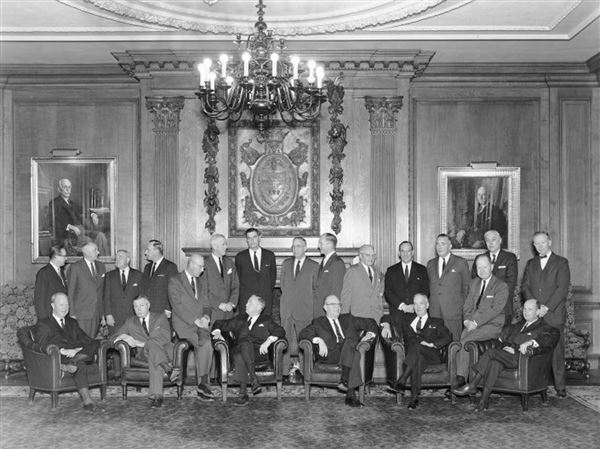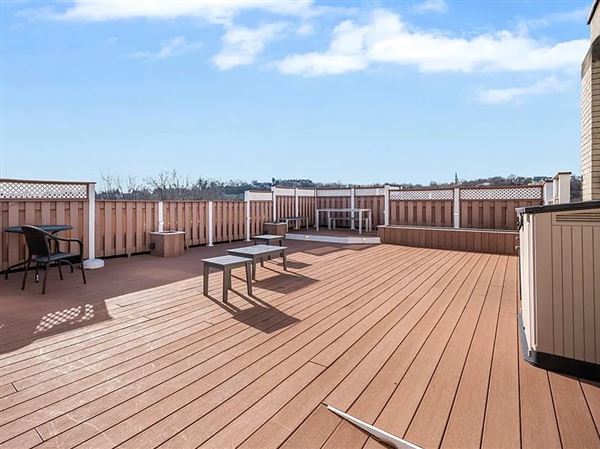There's a certain allure about living in an old apartment building. Who can resist architecture of a bygone era, history which says something about its past or an uncommon floor plan so often missing in today's cookie-cutter apartment complexes?
Sometimes hard to find, it's often word of mouth that leads a potential renter to that special apartment like a buddy to a long lost friend.
That's how Craig Hoge learned a two-bedroom flat was available in Monongahela. He was living in another less appealing place around the corner when his current apartment became available in September.
One look was all it took to decide to rent the same day. It is homey, cozy and, at 1,250 square feet, large enough to accommodate a party of 12, which Mr. Hoge recently did.
"I wasn't expecting what I saw. I was expecting a nice place but nothing as large as or as updated as this," he said.
He moved from Michigan three years ago after his divorce, and was surprised to learn of the third-floor apartment above a busy street. Well-insulated walls shield him from the noise and traffic.
But when he feels like indulging in people watching, there's a veranda with an awning to enjoy the view.
"I'll sit out there in the cold. Since I work late at night, sometimes I just need to relax. It's quiet out there at that time of night," he said.
A glass door to the apartment opens to a narrow hallway with rooms on the right. In the living room, a gas fireplace, its bricks painted white, helps raise the comfort level. The room's furnishings are the first clue Mr. Hoge is keen on antiques and has been since high school, when he acquired his first piece.
"To me, antiquing or collecting is kind of relaxing. Plus, it's sort of a social thing to do. I know many of the antique dealers around here, and I just go there to chit chat and I end up walking out with something."
Among his eclectic mix of pieces is a carpenter's chest retooled as a coffee table in the living room. Now filled with magazines, he calls the "coffee table" functional and attractive.
Also in the room are several Windsor chairs, one a rocker which faces the fireplace.
"Obviously, I like Windsors," he said laughing. "I'm not really into period anymore. I used to ... strictly want a certain period, a certain style, but now I just kind of mix it up. If I see it and I like it and I think it'll go, I put it together and it seems to work."
Among the pieces that seem to work is a threesome of Fenton art glass, a matching set of a hurricane lamps, a bell and a small basket, all displayed atop a desk in his living room. The milky white set -- Fenton is known for its colored glass -- is decorated with a country scene painted in sepia tones. Fond of the artwork, Mr. Hoge counts among his finds several other Fenton pieces.
Throughout the apartment, Mr. Hoge combines the old and the new, including pieces dating from the 1830s to the present.
The furnishings are set amid a neutral color scheme, but Oriental rugs of predominantly red provide contrast.
"I like art, period, so it's like having a painting on the floor," he said of the rugs.
Next to the living room is his bedroom, which can be closed off by pocket doors, although Mr. Hoge prefers to leave them open. In the bedroom is the first antique he acquired as a high school student: a compact secretary bookcase ideal for the confines of a bedroom. Instead of books, it holds his collection of Celtic deities, reflecting his Scottish heritage.
He also collects ceramic Scottish terriers, most of which are in the utility room. Dozens of Gaelic music compact discs reveal his love of that genre.
Mr. Hoge also has a penchant for Victorian-style prints of ladies, some posed demurely, which hang on walls throughout the apartment.
"I just think they're gorgeous," he said of the prints by different artists.
At the end of the hall past the bathroom and a guest bedroom is the dining room, Mr. Hoge's favorite. Like the living room, it has a fireplace, where guests seem to enjoy gathering.
It is furnished with an antique country style dining table from Ontario and a pie safe, dating to between 1850 and 1890. It serves as a buffet when he throws a party, but usually houses dishes in varied patterns of blue.
A china cabinet with leaded glass dating from the 1890s or early 1900s and which Mr. Hoge received from his mother, Isabel, occupies one corner.
It seems as if he can relate a story about each piece. The walnut Belgian parlor table in the dining room was among the first pieces he bought for $20 and was stained shoe-polish black. He recalled having it stripped and refinished and it now counts as one of his favorites.
Decorating one wall is his family tree, marked by branches representing married couples and leaves identifying offspring. It was done in the 1890s and dates to Solomon Hoge who came to this country in the 17th century, Mr. Hoge said.
"Having come from Michigan but being born in Illinois, my family actually settled in this area [in Pennsylvania] and one of my distant relatives platted the city of Washington," he said.
The kitchen marks his "teapot phase," duly noted by their places atop the cabinets.
Mr. Hoge said it was fun to select and display his antiques.
"It just fits with where I'm at in life for some reason. But people, when they come in, they love it. If it gives them pleasure, that's great," he said.
First Published: February 19, 2006, 5:00 a.m.
















